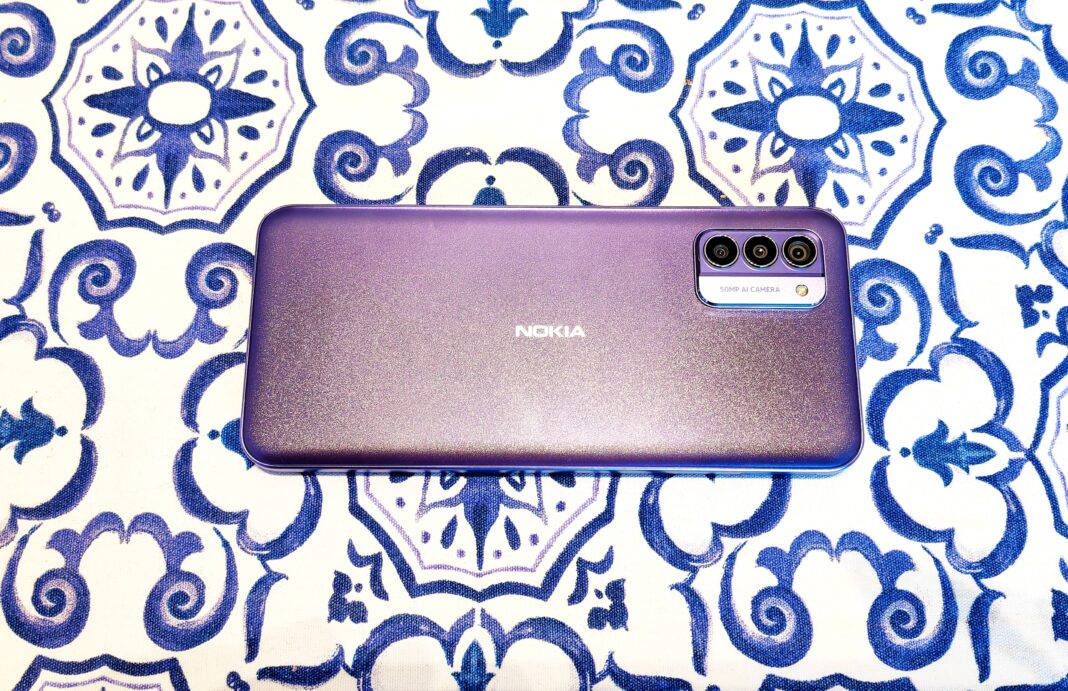Sure, you could choose the “So Grey” color variant of Nokia’s G42 and then get a rather classically designed phone with rounded corners, a plastic back that also contains recycled materials, and the display is protected by Gorilla Glass 3. However, the phone only gets really exciting when the violet “So Purple” variant is selected: Then small particles glitter and light reflections twitch across the back, and the camera module also adapts to the purple design in terms of color. In any case, you get a cell phone that sits comfortably in the hand with its 194 grams and cannot be twisted.
However, you can press the back cover in a bit in the middle, pressure also gets through to the screen’s liquid crystal. Nokia ships the phone in a plastic-free package and offers in cooperation with iFixit relatively inexpensive replacement parts, as well as instructions with which one can exchange the battery, screen, or the back itself. This is not witchcraft but also not so easy that any layman will dare to do it.
The phone is equipped with NFC so that mobile payment services can be used without problems. It is also possible to use an FM radio, which is convenient when you do not have an Internet connection or do not want to spend data volume. However, a suitable headset as an antenna replacement is not included in the package.
The Nokia G42 is a dual-SIM phone, but one SIM slot is also used as a microSD slot, so you have to decide which to use. If it is to be the microSD, the reader proves to be a bit slow in the copy test with the reference microSD Angelbird V60 in our test, but again delivers good results in the CPDT benchmark, so a medium speed is to be expected overall. Nokia’s G42 is a 5G smartphone, so you can also use the fastest mobile standard.
The phone offers enough LTE and 5G frequencies for use abroad, but you should check in advance whether you can use the phone for mobile Internet on site. The reception strength was at a high level during our test phase. WiFi 5 is integrated as the fastest WLAN standard.
Nokia’s G42 shows very stable transfer rates in our test with the reference router Asus ROG Rapture AXE11000, which are within the class-standard range of 317 – 380 Mbps. A Gigabit line cannot be fully utilized, but it is still sufficient for fast page loads and downloads. Android 13 without changes to the interface is installed on Nokia’s G42 ex-works, but the manufacturer adds some third-party apps, for example from shopping portals.
These can be uninstalled without any problems. The security updates are from June 2023 at the time of testing and are thus still fairly up-to-date. The manufacturer promises 3 years of security updates from market launch – until 2026.
There are also supposed to be two major versions of the operating system, so phone should also receive Android 15. The touchscreen is very fine to use and the operation seems even smoother thanks to the 90 Hz display. On the right side of the casing is the standby button, which also functions as a fingerprint sensor.
The phone can be unlocked biometrically with it. This works very reliably after a one-time teach-in but Nokia’s G42 occasionally allows itself a short delay before the screen is unlocked. Face recognition can also be used.
This also works reliably but is not quite as secure due to the recognition of 2D images. There are three camera lenses at the back. The macro lens with 2 megapixels is more for snapshots and can only be used in a special mode of the camera software.
The depth camera only provides additional info for blur effects in portraits and cannot take its own photos. That leaves the main camera with 50 megapixels, which relies on the commonly found Samsung Isocell JN1 as a sensor. Nokia’s 5G phone takes decent pictures with good sharpness, but you will quickly notice that there is only a little dynamic range on rainy days.
The detail diversity is also higher in higher-quality cameras. In low light, many details are lost in both bright and dark areas, but the quality in the illuminated area is decent. The main camera performs well in the lab and hardly loses any sharpness at the edges.
Videos can be recorded in 1080p at a maximum of 30 fps. The autofocus works quickly and without pumping, and the brightness adjustment also works quite well. The resulting movies are of decent sharpness, but the lighting should be good, otherwise, there is a lot of noise.
An 8-megapixel sensor is used as the selfie camera on the front. The pictures are quite usable in good light. Unfortunately, the Nokia G42 only has a 720p screen, which is also surpassed by other devices in the price range in terms of brightness.
Right in front here is the Xiaomi Redmi Note 12 5G , which even has an AMOLED screen. We see a rather heavy blue cast in the display, which distorts the color reproduction and makes pictures look cooler. In addition, the black value is quite high, and the contrast is only mediocre.
At least we did not notice any annoying PWM flickering at low brightness. The Snapdragon 480 Plus 5G is a bit older, namely from 2021, but it still offers enough performance for mostly smooth system operation and can also be entrusted with somewhat more demanding tasks like photo editing. Although Nokia’s smartphone uses high-performance UFS 2.
2 storage, the storage controller cannot fully utilize the storage’s possible speeds. Thus, it is only sufficient for transfer rates on the class level with occasional waiting times during data transfers and loading times. The phone gets noticeably warm with a maximum of 43.
1 °C under a longer load, but it is not a critical temperature increase. This is also shown by the long-term tests, which certify a similar performance after 20 runs of the same benchmark. The speaker on the bottom edge of Nokia’s G42 is not a revelation in terms of quality and sounds a bit muffled overall.
The “Audio Boost” feature can be activated by pressing the volume up button again, then the sound becomes clearer, but also very treble-heavy and even a bit louder. If you prefer to connect headphones or speakers, you will find a jack socket and Bluetooth 5. 1.
The most important standards are available in terms of codecs for wireless audio transmission: SBC, AAC, LDAC, and some aptX codecs. The 5,000 mAh battery enables Nokia’s G42 5G to run for a decent 15:33 hours in our WLAN test. There are phones in this price range that last much longer, but the phone generally cuts a good figure in everyday use and usually accompanies you through the day without a charging stop.
The Nokia G42 5G can be charged with up to 20 watts, but there is no charger in the package. It takes well over 2 hours until the battery indicator is back to 100% when the battery is completely empty. Nokia’s G42 does have a few special features: Besides a daring color option, it is relatively easy to repair for tinkerers, has a share of recycled materials, and comes with an update promise from the manufacturer despite its low price.
It is a pity that the Nokia G42 cannot currently be rented from Nokia as part of a circular subscription. The processor is fast enough, the screen sufficient for everyday use and the camera takes decent pictures. However, the Nokia G42 5G cannot stand out from comparable phones in any of these areas.
The battery life and WLAN speed are also mediocre rather than leading. For everyday use, Nokia’s G42 is a cheap and reliable companion that should get long updates and can also be used sustainably due to its relatively easy repairability. More of a highlight in terms of features is the Xiaomi Redmi Note 12 5G with AMOLED display, but sustainable aspects tend to take a back seat here.
Another interesting cell phone with fast mobile communication in the price range is the Samsung Galaxy A14 5G . In the US, users can order the phone via Amazon for around $335 . .
From: notebookcheck
URL: https://www.notebookcheck.net/Nokia-G42-5G-smartphone-review-With-this-eye-catcher-you-can-even-swap-the-battery.740282.0.html



